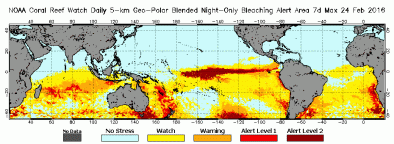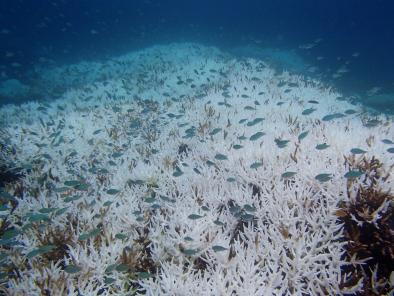

Coral Bleaching Increase
The rate and magnitude of climate disruption on coral reefs is already testing the ability of organisms to adapt, leading to increased risk of extinction, biodiversity loss, and the compromising of ecosystem services. Ecosystems depend upon biodiversity to be healthy and to ensure protection against disruption and disaster. As ocean temperature increases, only the most resilient species, are able to thrive in a warmer climate.
Read More



Background
About 93 percent of the heat trapped by greenhouse gas emissions since the 1970s has made its way into the oceans.[1] Increased sea surface temperature makes mass coral bleaching events more frequent and severe. When sea surface temperatures rise above average (typically by 1.0–1.5°C above seasonal maximum mean temperatures) in reefs that receive a relatively high amount of light, the algae start producing toxic compounds, prompting the corals to expel them and turn white.[2][3]
Once bleached, the corals are physiologically damaged and more susceptible to disease.[4][5] Widespread bleaching becomes likely when corals are exposed to more than four accumulated weeks of heat stress and excessive sunlight.[3][6]
It is possible for corals to recover,[7] but if water temperatures take too long to return to normal, the organisms actually starve and die.[7][8] Significant bleaching or death is possible after eight accumulated weeks of heat stress.[6]
Global trends
In the last three decades, 19 percent of global coral reef area has been lost due to coral bleaching.[8] Global-scale bleaching events were not observed until 1998.[9]
Global warming triggered the Earth’s third global coral bleaching event, which began in the north Pacific in the summer of 2014 and became global in 2015. The fingerprint of global warming was found in this event.[10]
There is indisputable evidence climate change is harming the Great Barrier Reef. Climate change has increased sea surface temperatures in the hottest March months by just over 1°C.[11]
Abnormally warm ocean temperatures linked to anthropogenic greenhouse gas emissions may have increased the probability of occurrence of thermal stress events like the 2005 eastern Caribbean coral bleaching event by an order of magnitude.[12]
The two earlier global coral bleaching events on record lasted only one year each.[13] They were observed in 1998 and 2010, meaning all such events have taken place within the last 20 years.









